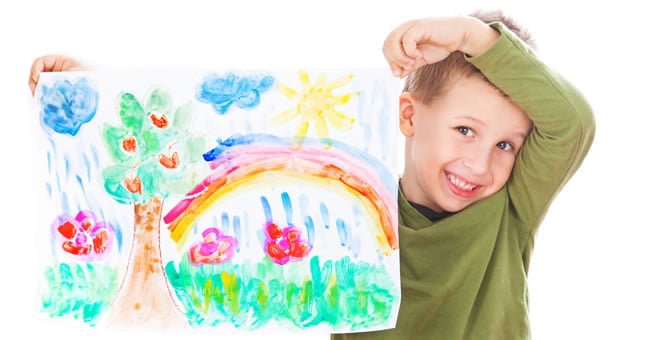
Painting is a great creative outlet for kids and provides plenty of educational opportunities, but deciding which type of paint would be best for kids to use can be difficult due to the variety of choices available. If the children in your care are younger and in their early developmental stages, two paints for kids you should consider are tempera paint and finger paint. Both of these kids' paints have similar qualities that make them good to use for kids' art projects, but they also have some differences that create a distinct experience with each.
Kids' Tempera Paint
Also known as poster board paint, tempera paint is great for crafts and art projects because it's fast drying, long lasting, and easy to clean. It's also not likely to flake, streak, or crack. Tempera paint is water-soluble, and the majority of tempera paint available is non-toxic. The paint's creamy consistency helps it flow smoothly onto paper, cardboard, cloth, wood, or canvas and provides excellent coverage, which allows kids to use a variety of creative painting techniques.
Tempera paint is popular in schools and can be used for finger painting or applied with a brush. Most varieties dry to a matte or satin finish. Tempera paint comes in vibrant, bright colors that mix well together, which enables you to create any color you want with just a few basic colors. Fluorescent and metallic colors are also available with the choice of purchasing either powdered or premixed tempera paint. There is an egg-based variety of tempera paint, but we sell kid-friendly tempera poster board paint to help you purchase products that are safe for the children in your care who may be allergic to eggs or have other food allergies.
Kids' Finger Paint
Finger painting is an excellent way for kids to learn and play. Children will enjoy the process of creating art with their hands and using their imagination to come up with ideas they can paint on paper. Finger painting also teaches self-expression and can help children develop gross and fine motor skills. Even though finger paint can be quite messy, it is water-soluble and washes easily from skin and the majority of fabrics.
Finger paint colors are bright and contrasting, which encourages children to experiment with mixing colors and using different textures. Glitter finger paint is also available for purchase. Kids can use their finger and thumb prints in their design or use different objects, such as stamps, sponges, or brushes, to make different patterns. Finger paint is creamy and resists splashing and run off, which makes it a great starter paint for kids to learn about different painting techniques. We sell non-toxic varieties of kids' finger paint to help ensure that the children in your care can learn and play safely.
What's the Difference?
The biggest difference between tempera paint and finger paint is that tempera paint has more multi-use purposes. There are also several varieties of tempera paint available, such as powdered tempera paint, liquid tempera paint, egg-based tempera paint, and tempera poster board paint. Finger paint, however, works well as a basic starter paint for young children and encourages early childhood development. Finger painting is an excellent way to teach self-expression, and the repetitive hand movements required in finger painting will help young children develop muscle control.
Children will enjoy using either kind of paint, so it's up to you to decide which paint would be best to use for the art projects you have planned. Once you've made your decision, don't forget your art station will need a variety of children's brushes, paint pots, paint cups, and drawing materials.
